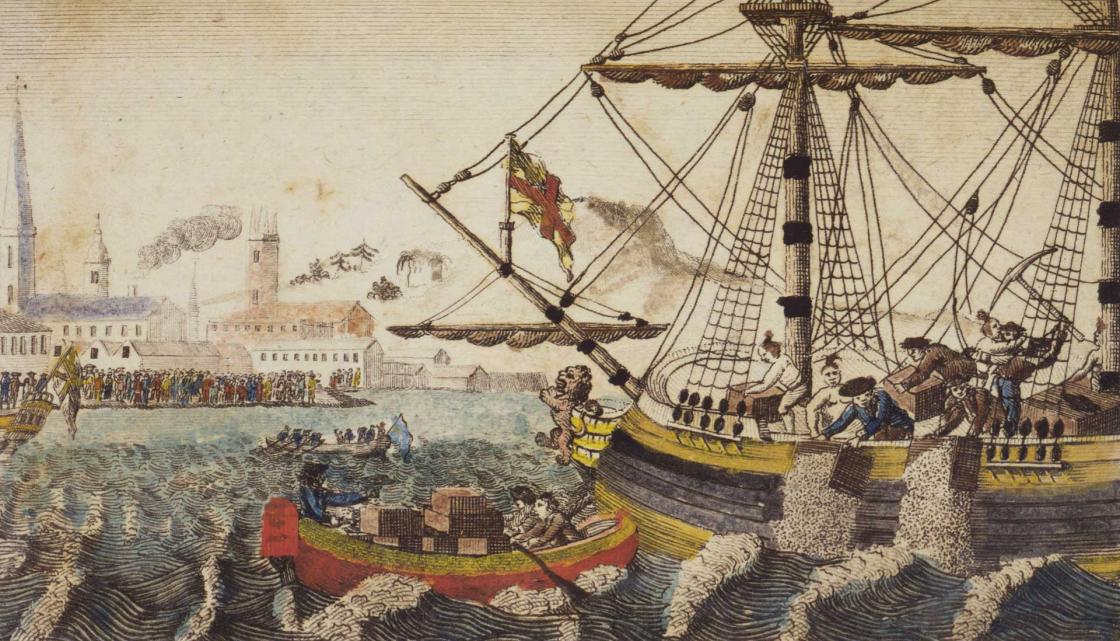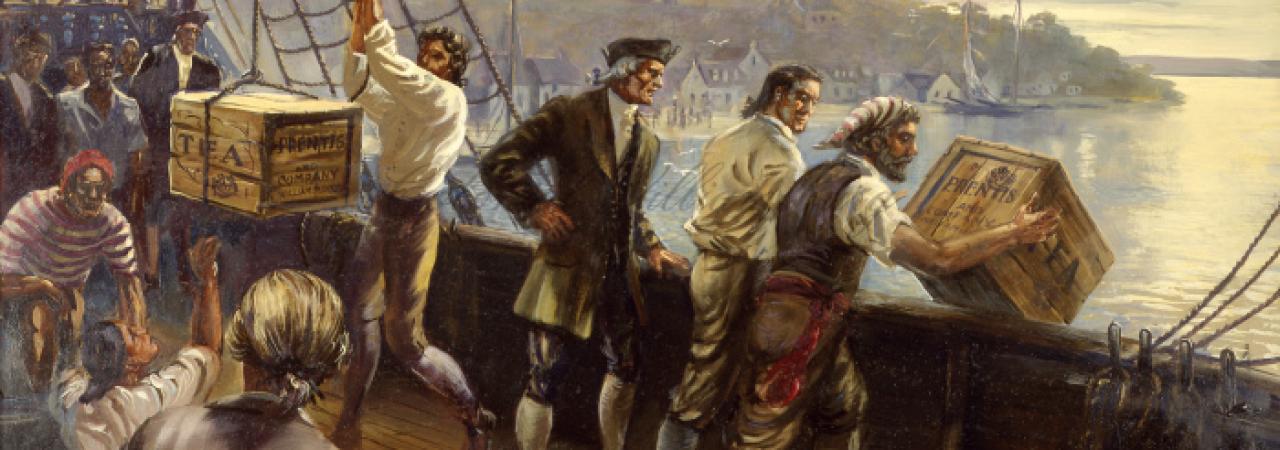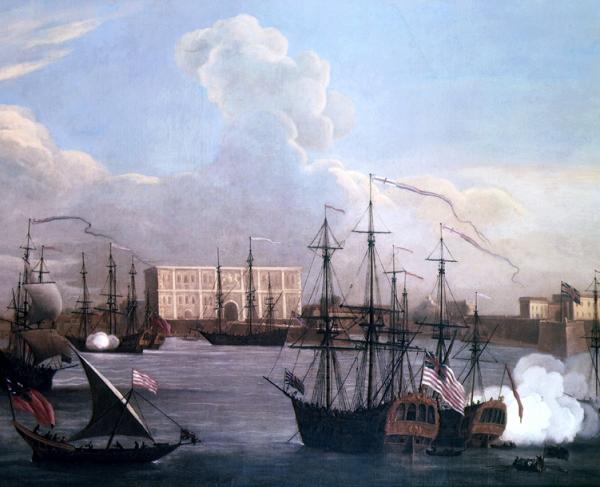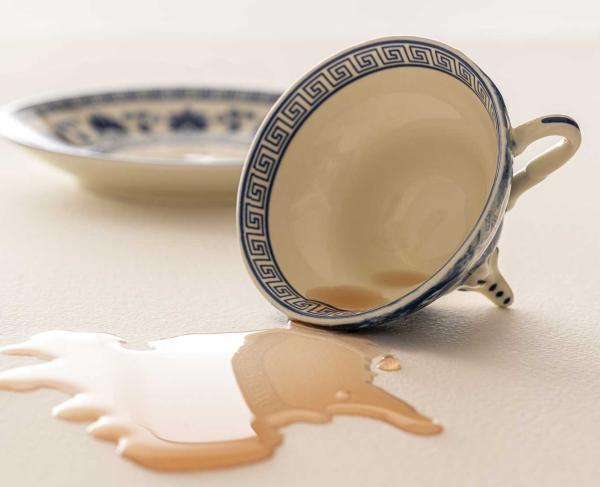Tensions between Great Britain and the American colonies had been growing in the years following the French and Indian War. In May, 1773 the British Parliament passed the Tea Act, a law which enraged American colonists. Not because it raised taxes, in fact the Act lowered taxes on imported British tea. By lowering the tax, it was hoped more consumers would buy this tea. The regulation included several other provisions that angered Americans, such as a bailout of the struggling East India Company (which imported the tea) and tougher laws to crackdown on smuggling. As much as 90% of the tea consumed by Americans was actually smuggled in.
The December 16, 1773 Boston Tea Party was the result. Yet the destruction of tea in Boston Harbor was only one of many Tea Parties held in various colonies (though it was by far the most famous and most destructive of them). In fact there were seventeen tea parties in total before the war, some more violent than others.
The tea that most Americans consumed was Bohea, a Chinese tea that was pressed and made into bricks. Another was Hyson, a Chinese green tea. The East India Company, financially in debt, hoped to undercut smuggling by having the taxes lowered on its imported tea. Word of the new Act sparked outrage up and down the colonies and many Americans stopped consuming it and planned various ways to retaliate.
The first Tea Party, or protest, against the Tea Act occurred on December 3, 1773 in Charleston, South Carolina. Led by Christopher Gadsden and the Sons of Liberty, they seized tea that had arrived by ship, placed it in the Exchange (a government building), and started a boycott of imported tea.
The next was on December 12 in Lexington, Massachusetts, where the first shots of the war would be fired two years later. Citizens published a resolution against consuming tea, and publicly burned tea in the town.
Then was the famous Boston Tea Party, held on the night of December 16. In what was a prearranged plan, a mob disguised as Indians dumped 342 chests of tea from four ships into the harbor. Each chest weighed 260 pounds, so the boxes themselves were not thrown overboard, but chopped open, and their contents poured into the water. The process took over three hours. In places the tea was so thick that it would not sink, so several men had to go around in small boats with oars to break it up, spread it out and push it down into the water. An estimated 100 protestors did the work, destroying about 92,000 pounds of tea, worth over a million dollars in todays’ money.

A few days later was Philadelphia’s non-violent Tea Party. A ship arrived with the hated tea, and the captain was informed by the ‘committee of tarring and feathering’ what his fate would be if it was unloaded. The Captain turned his ship around, and the largest shipment of tea to the colonies- 697 chests, never landed.
Number five occurred at Provincetown, Massachusetts on the last day of 1773. A Boston-bound ship ran aground at Cape Cod, and local seized its tea and took it to the Fort at Castle Island. The tea was bought by a merchant, and when discovered, seven ‘Mohawks’ arrived at his residence, took the tea (three chests), and burned it.
Tea Party number six was at Princeton, New Jersey in January, 1774. At the College of New Jersey (now Princeton University), students broke into the College’s storeroom to access a stash of tea. Student Charles Beatty wrote that they “gathered all the steward’s winter store of tea and having made a fire on the campus we there burned near a dozen pound, tolled the bell, and made many spirited resolves.” They also made an effigy of Massachusetts Governor Hutchinson (a pro-British official), tied a tea canister around its neck, and burned it in front of Nassau Hall.
Next on April 22 was the New York Tea Party, though it could rightfully be claimed by Sandy Hook, New Jersey. On April 18, the Nancy landed at Sandy Hook with a cargo of 690 chests of tea. The captain was advised to return to England or to lose his life, and local civilians took charge of the ship. They held the crew hostage and escorted the captain into New York City, where he agreed to return to England with the tea.
Four days later the ship London arrived, and its captain claimed that he had no tea aboard, but the local Sons of Liberty learned that there were eighteen chests hidden onboard, being smuggled for the profit of the Captain. He was seized, the ship was searched, the chests were discovered, opened, and dumped into the Hudson River. The empty tea chests were then brought to the city, where they were used to ignite bonfires in the streets.
A second Boston Tea Party took place on March 6, when about sixty men boarded a ship and dumped twenty eight chests of tea into the harbor. The importing merchant had brought tea that was not from the East India Company in hopes that it would be allowed. No such luck.
Party number nine is a questionable event, but here is the claim: On May 13 citizens of Chestertown, Maryland, boarded a ship at the town wharf and dumped tea into the Chester River. The problem is that there is no primary source documentation for the event, its first recording dates to 1899. Chestertown did produce a Resolves that affirmed its opposition to the taxes and to importing tea. Despite its questionable origins, the town commemorates a Tea Party event every year.
In Wilmington, North Carolina, town women burned their tea “in a solemn procession.” Details are sketchy, but it took place in late March or early April, and the place and amount is not known. Apparently the effort was entirely led by women. The only eyewitness was a disapproving pro-British observer, and there are no other accounts of the event.
In July 1774 Charleston, South Carolina held a second Tea Party, in which imported tea was seized from newly arrived ships, but its fate remains unknown. The importing ships’ captain claimed to not know that it was aboard, and a mob threatened to tar and feather him, but he talked is way out of the situation.
On September 15 in York, Maine (then still part of Massachusetts), imported tea was removed from a ship and subsequently ‘stolen’ by ‘Pickwacket’ Indians. The 150 pounds of tea was likely consumed by locals after seizing it.
Annapolis, Maryland had a Tea Party on October 19 when imported tea arrived on the ship, Peggy Stewart. A mob forced the ship’s owner to move it out into the harbor and burn it, tea and all.
A second Tea Party in North Carolina (number fourteen) was also led by women, in the coastal town of Edenton on October 25. It involved no seizure or destruction, but was a a protest. Penelope Barker gathered fifty-one women who signed a statement affirming their resistance to the tea and taxes, and even sent it to a London newspaper for publication. Her letter read, in part:
The Provincial Deputies of North Carolina, having resolved not to drink any more tea, nor wear any more British cloth, many ladies of this province have determined to give memorable proof of their patriotism, and have accordingly entered into the following honourable and spirited association. I send it to you to shew your fair countrywomen, how zealously and faithfully, American ladies follow the laudable example of their husbands, and what opposition your matchless Ministers may expect to receive from a people thus firmly united against them.
Charleston, South Carolina had a third Tea Party (number fifteen) on November 3, when a ship with seven chests arrived. Three city merchants admitted to ordering the contraband, and a mob forced them to dump it into the harbor.
Yorktown, Virginia, where the war’s last major battle would take place, had a Tea Party on November 7, 1774. Townspeople seized two chests of imported tea and poured it into the York River. The Virginia Gazette reported, “We will never submit to any measure that may in the least endanger our liberties, which we are determined to defend at the risk of our lives.”
The last Tea Party (number seventeen) was in Greenwich, New Jersey, on December 22. A ship of tea arrived, destined for Philadelphia. Ironically, this was tea being smuggled in, but locals found out about it, seized it, and burned it on the town square.
Each Tea Party was different in size, with some simply turning the tea away, some seizing it, and others destroying it. None of the protests or violence resulted in deaths. Some were well organized, others spontaneous. They all were independent actions, lacking overall coordination. It is safe to say that nearly every major American port had its own Tea Party or protest.
Events escalated quickly following these protests. The British government closed the port of Boston in December, 1773. In addition, the colony lost some governing authority, and British troops arrived to maintain order. In the meantime a provisional congress met in Concord to assume local leadership and spearheaded resistance. Both sides began stockpiling weapons and spying on the other. Violence broke out just a year later in April, 1775 at Lexington and Concord.
The term ‘Tea Party’ was not actually used at the time and was coined in the 1830s when the Revolutionary generation looked back with nostalgia fifty years later. December 2023 marks the 250th anniversary of the Boston Tea Party. Celebrate with a toast of your favorite beverage (even tea is ok!).




